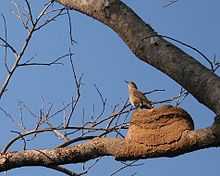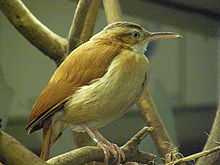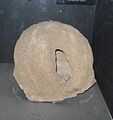Hornero
| Hornero | |
|---|---|
 | |
| Rufous Hornero building a nest in Minas Gerais, Brazil | |
| Scientific classification | |
| Kingdom: | Animalia |
| Phylum: | Chordata |
| Class: | Aves |
| Order: | Passeriformes |
| Family: | Furnariidae |
| Genus: | Furnarius Vieillot, 1816 |
| Species | |
|
See text | |
The horneros are members of the genus Furnarius in the family Furnariidae, native to South America.
Horneros are brown birds with rather short tails and fairly long bills. They are known for building mud nests that resemble old wood-fired ovens (the Spanish word "hornero" comes from horno, meaning "oven"). While many Furnariids have different nests, the hornero nest is the reason for the common name applied to the entire family; Ovenbirds (though unrelated to the Ovenbird, which is a parulid warbler). The size and exact shape of the hornero nest varies depending on the species. They generally lay 2–4 eggs, although the breeding behavior of the Bay Hornero is virtually unknown.
Adult horneros can frequently be seen sitting on top of their nest. Disregarding the uncommon and relatively shy Bay Hornero, horneros are typically fairly common and highly conspicuous birds. They are generally noisy. All horneros are partially terrestrial, and commonly seen walking on the ground with a relatively up-right posture.
The Rufous Hornero is a national emblem of Argentina and Uruguay, two of the several countries it inhabits.
Species
- Pale-legged Hornero (Furnarius leucopus).
- Pacific Hornero (Furnarius (leucopus) cinnamomeus).
- Caribbean Hornero (Furnarius (leucopus) longirostris).
- Bay (or Pale-billed) Hornero (Furnarius torridus).
- Band-tailed Hornero (Furnarius figulus).
- Lesser Hornero (Furnarius minor).
- Rufous Hornero (Furnarius rufus).
- Crested Hornero (Furnarius cristatus).
| Wikimedia Commons has media related to Hornero. |
Image gallery
-

Pacific Hornero
-

Hornero nest
References
- "Furnarius". Integrated Taxonomic Information System. Retrieved 13 March 2006.
External links
- Hornero videos on the Internet Bird Collection